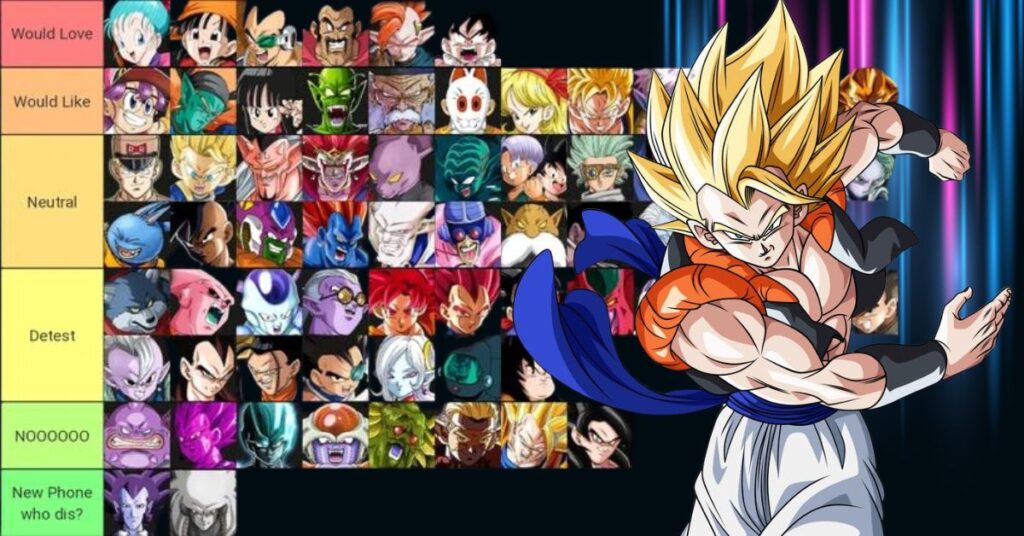I. What is a Tier List?
A tier list is a ranking system used to categorize items, characters, or other elements in a particular subject based on their perceived strength, effectiveness, or value. This system is commonly used in video games, sports, and other competitive activities to help players or participants understand the relative power levels of different options.
In a tier list, items are typically divided into different tiers, with each tier representing a certain level of performance or desirability. The top tier usually includes the most powerful or effective options, while the lower tiers consist of less desirable choices.
Tier lists are often created by experts or experienced players who have a deep understanding of the subject matter and can provide valuable insights into the strengths and weaknesses of different options.
While tier lists can be helpful for players looking to improve their performance or make informed decisions, it’s important to remember that they are not definitive and can vary depending on individual playstyles, strategies, and preferences. Additionally, tier lists are not static and can change over time as new information or strategies emerge.
Briefly explain tier lists in fighting games.
In the realm of fighting games, tier lists serve as a crucial tool for players seeking to understand the competitive landscape and make informed decisions about character selection.
These lists categorize fighters based on their perceived strength and effectiveness in gameplay, providing valuable insights into the meta-game dynamics. The top tier typically comprises characters considered the most powerful and versatile, possessing movesets or attributes that grant them a significant advantage over lower-tiered counterparts.
Conversely, lower-tiered fighters are deemed less potent or more challenging to succeed with due to perceived weaknesses or limitations. Tier lists in fighting games are often crafted by seasoned players, analysts, or community members who possess a deep understanding of the game mechanics, matchups, and evolving strategies.
These lists are dynamic, subject to frequent revisions as the meta-game evolves through patches, balance changes, or new discoveries.
While tier lists can offer valuable guidance for players aiming to optimise their gameplay or tournament performance, it’s essential to approach them with a critical mindset, considering personal playstyle preferences and the nuances of individual matchups.
How characters are ranked (S, A, B, etc.)
In the realm of character rankings in various competitive settings, such as video games or sports, the use of letters like S, A, B, etc., to classify characters within tier lists is a common practice.
The letter grading system provides a straightforward and intuitive way to convey the relative strength and viability of each character in comparison to others. The ‘S’ tier typically designates the most dominant and potent characters, often possessing exceptional abilities, versatility, or tools that grant them a significant advantage in gameplay.
Characters placed in the ‘A’ tier are considered strong and competitive, while those in the ‘B’ tier may have noticeable weaknesses or limitations that hinder their performance against higher-tiered counterparts.
The ranking of characters into specific tiers is often determined by a combination of factors, including their overall power level, effectiveness in different scenarios, matchup spread, and the consensus of experienced players or analysts within the community.
These rankings are not fixed and can shift over time due to balance updates, meta-game shifts, or evolving strategies. Understanding how characters are ranked within these tiers can provide valuable insights for players seeking to optimise their gameplay and make strategic decisions in competitive environments.

II. Factors Affecting Tier Placement
When it comes to determining the tier placement of characters in various competitive environments, several key factors come into play to influence their ranking. One significant factor is the character’s overall strength and effectiveness in gameplay.
This includes assessing their moveset, abilities, and unique traits that contribute to their performance. Characters with versatile tools or powerful abilities are more likely to be placed in higher tiers due to their competitive advantage.
Another crucial consideration is the character’s matchup spread, which refers to how well they fare against other characters in the game. Characters with favourable matchups across a wide range of opponents are often ranked higher as they have a better chance of success in various scenarios.
Conversely, characters with numerous unfavourable matchups may find themselves placed lower in the tier list. The consensus of experienced players, analysts, and the community also plays a significant role in determining tier placement. Insights from those deeply involved in the competitive scene can offer valuable perspectives on a character’s strengths, weaknesses, and overall viability.
Additionally, factors such as balance updates, meta-game shifts, and evolving strategies can impact a character’s tier placement, leading to dynamic changes in the tier list over time. Understanding these factors is essential for players looking to navigate the competitive landscape effectively.
Offense
In various competitive contexts, ‘offense’ refers to the strategic approach or gameplay style focused on actively engaging and pressuring opponents to secure advantages or achieve objectives. Offense involves tactics aimed at creating openings, applying pressure, and capitalising on opportunities to control the flow of the game.
Players employing an offensive playstyle often prioritise aggressive actions, such as initiating attacks, pursuing advantages, and maintaining momentum to keep opponents on the defensive. Effective offense requires a combination of skill, timing, and adaptability to outmanoeuvre opponents and exploit their weaknesses.
Players utilising offensive strategies must strike a balance between calculated risk-taking and tactical decision-making to optimise their chances of success. Offense can manifest in various forms, including aggressive rushes, strategic positioning, and coordinated team plays, depending on the specific context of the game or sport.
Understanding the nuances of offensive gameplay is essential for players looking to assert dominance, create scoring opportunities, or disrupt opponents’ strategies effectively. By mastering offensive techniques and strategies, players can enhance their competitive performance and contribute significantly to their team’s success.
Damage output
Damage output refers to the amount of harm or injury that a character, weapon, ability, or attack can inflict on opponents in a game or competitive setting. It is a critical metric used to evaluate the offensive capabilities and effectiveness of various elements within the game.
A high damage output indicates that a character or weapon can deal significant harm to opponents, potentially leading to quicker eliminations or victories.
Understanding the damage output of different options allows players to make informed decisions about their strategies, character selection, and combat tactics.
Factors influencing damage output include the strength of attacks, the frequency of hits, critical hit chances, and any additional modifiers or buffs that enhance damage-dealing capabilities. Players often seek to maximise their damage output to secure advantages, control engagements, or outpace opponents in combat scenarios.
Balancing damage output with other factors such as speed, accuracy, and defensive capabilities is crucial for creating a well-rounded and effective gameplay experience. By mastering the concept of damage output, players can strategically leverage their offensive capabilities to gain a competitive edge and achieve success in the game.
Combo potential
Combo potential refers to the ability of a character, weapon, or set of actions in a game to string together a sequence of moves or attacks seamlessly and effectively. A high combo potential indicates that the character or tool can execute intricate and damaging combinations that flow smoothly from one action to the next.
Understanding and utilising combo potential is crucial for players looking to maximise their offensive capabilities, create pressure on opponents, and secure advantages during gameplay.
Factors that influence combo potential include move properties, frame data, hitboxes, cancel windows, and the synergy between different attacks or abilities. Skilful players can exploit these mechanics to create devastating combos that deal significant damage, control opponents’ movements, or set up advantageous situations for further attacks.
Mastering combo potential requires practice, timing, and a deep understanding of the game’s mechanics to execute complex sequences with precision and efficiency. By harnessing the combo potential of characters or tools within the game, players can elevate their gameplay, showcase their skill and creativity, and outmanoeuvre opponents with stylish and effective combinations.
The strategic use of combo potential can be a defining factor in achieving success and dominance in competitive gaming environments.
Defense
In the realm of gaming and competitive sports, ‘defense’ encompasses the strategic approach or gameplay style focused on mitigating damage, countering opponent’s attacks, and maintaining resilience against incoming threats.
Effective defense involves tactics aimed at protecting oneself, anticipating enemy movements, and minimising vulnerabilities to sustain longevity in the game. Players employing a defensive playstyle often prioritise reactive actions, positioning, and resource management to withstand pressure and outlast opponents.
A robust defense requires a combination of situational awareness, adaptability, and timing to effectively block, dodge, or counter incoming attacks. Players utilising defensive strategies must strike a balance between patience, discipline, and calculated responses to weather opponent’s assaults and create opportunities for a counter-attack.
Defense can manifest in various forms, including evasive manoeuvres, shield usage, crowd control, and team coordination, depending on the specific context of the game or sport. Understanding the nuances of defensive gameplay is essential for players looking to endure prolonged engagements, capitalise on opponent’s mistakes, or disrupt aggressive strategies effectively.
By mastering defensive techniques and strategies, players can enhance their survivability, withstand enemy onslaughts, and contribute significantly to their team’s resilience and success.
Mobility
Mobility in gaming and competitive sports refers to the ability of a character, player, or team to move swiftly, adaptively, and efficiently across the game environment. High mobility allows individuals to reposition, engage, disengage, or traverse the playing field with speed and agility.
Players with superior mobility can outmanoeuvre opponents, control engagements, and access strategic locations more effectively, enhancing their overall gameplay experience.
Factors influencing mobility include movement speed, acceleration, jump height, dash abilities, teleportation skills, and other traversal mechanics unique to the game. Skilful players can leverage these mobility tools to create advantages, evade enemy attacks, or surprise opponents with quick and unexpected manoeuvres.
Mastering mobility requires spatial awareness, reflexes, and an understanding of map layouts to navigate efficiently and exploit movement mechanics optimally. By harnessing the potential of mobility within the game, players can gain a competitive edge, showcase their dexterity and strategic acumen, and adapt to dynamic gameplay situations with finesse and precision.
Mobility serves as a vital component of gameplay, allowing players to dictate the pace, control engagements, and seize opportunities for success in competitive environments.
Recovery options
Recovery options in gaming and competitive sports refer to the tools, abilities, or strategies available to characters or players to regain control, mitigate damage, or escape disadvantageous situations during gameplay. These options play a crucial role in enhancing survivability, resilience, and adaptability in the face of adversity.
Skilful utilisation of recovery options allows players to recover from setbacks, outlast opponents, and turn the tide of battle in their favour. Factors influencing recovery options include defensive abilities, healing skills, escape mechanisms, crowd control abilities, and other resources that enable players to recuperate, reposition, or reset engagements.
Players who master recovery options can effectively manage their health, resource pools, and positioning to withstand enemy pressure, recover from mistakes, and capitalise on openings to mount a counter-offensive.
Understanding and executing recovery options with precision and timing are essential for players seeking to maximise their survivability, strategic flexibility, and overall performance in competitive environments. By incorporating recovery options into their gameplay repertoire, players can enhance their resilience, adaptability, and capacity to navigate challenging scenarios with composure and effectiveness.
Assists
In the realm of gaming and competitive sports, ‘assists’ refer to the supportive actions, abilities, or mechanics that one player or character provides to aid their teammates or allies during gameplay. Assists play a pivotal role in enhancing teamwork, coordination, and strategic synergy within a team-based setting.
Players who excel in providing assists can bolster their team’s performance, create opportunities for successful engagements, and contribute to overall success in the game. Assists come in various forms, including healing abilities, crowd control effects, buffs, shields, or offensive support that can disrupt opponents or empower teammates.
Skilful use of assists requires situational awareness, communication, and a deep understanding of team dynamics to maximise their impact effectively. Players who adeptly utilise assists can turn the tide of battles, secure objectives, or provide crucial backup to teammates in critical moments.
Understanding the nuances of assists and incorporating them into gameplay strategies can elevate a team’s performance, foster collaboration, and lead to coordinated victories in competitive environments. By utilising assists effectively, players can showcase their support skills, enhance team cohesion, and contribute significantly to their team’s success.
Utility for your team
In gaming and competitive sports, ‘utility for your team’ encompasses the diverse set of tools, abilities, or strategies that a player employs to benefit their team’s overall performance, success, and strategic objectives.
Utility plays a critical role in enhancing team dynamics, creating advantages, and addressing specific needs or challenges within the gameplay environment. Players who excel in providing utility can significantly impact their team’s competitiveness, coordination, and ability to achieve collective goals.
Utility for the team can take various forms, including crowd control effects, healing abilities, vision control, map control, buffs, debuffs, or other supportive actions that contribute to the team’s success. Skilful utilisation of utility requires tactical awareness, decision-making skills, and effective communication to maximise its benefits and adapt to changing circumstances during gameplay.
Players who strategically leverage utility can bolster their team’s strengths, mitigate weaknesses, and enhance their overall performance in competitive settings. Understanding the significance of utility for the team and integrating it into gameplay strategies can elevate team synergy, foster collaboration, and lead to coordinated victories in challenging environments.
By providing valuable utility to their team, players can demonstrate their supportive capabilities, enhance team cohesion, and play a pivotal role in achieving shared objectives and triumphs.
Synergy with other characters
In the context of gaming and competitive sports, ‘synergy with other characters’ refers to the harmonious interaction, coordination, and compatibility between different characters or teammates within a team-based setting.
Synergy plays a pivotal role in enhancing teamwork, strategic cohesion, and overall effectiveness in achieving shared objectives. Players who demonstrate strong synergy with their teammates can amplify their collective strengths, cover weaknesses, and optimise their performance through coordinated actions and complementary abilities.
Synergy with other characters involves understanding each team member’s unique strengths, roles, and playstyles to create cohesive strategies and execute coordinated tactics effectively. Players who exhibit exceptional synergy can capitalise on each other’s strengths, cover vulnerabilities, and maximise their impact in critical moments of gameplay.
Effective communication, mutual trust, and a shared understanding of team dynamics are essential for fostering synergy and achieving synchronised gameplay. By cultivating synergy with other characters, players can enhance team cohesion, elevate strategic depth, and increase their chances of success in competitive environments.
Leveraging synergistic relationships allows players to unlock new possibilities, adapt to dynamic challenges, and showcase the power of collective teamwork in achieving victories and overcoming obstacles.
III. Current Top Tiers in Dragon Ball FighterZ (as of April 2024)
In the ever-evolving landscape of competitive gaming, the current top tiers in Dragon Ball FighterZ, as of April 2024, showcase a dynamic mix of characters revered for their potent abilities and strategic versatility. Characters like Goku, Vegeta, and Frieza continue to hold strong positions in the top tiers, owing to their well-rounded movesets, powerful supers, and effective mix-up potential.
These characters boast a blend of speed, power, and versatility that make them formidable contenders in high-level play. Additionally, newer additions to the roster, such as Android 21 and Jiren, have quickly risen through the ranks to establish themselves as dominant forces in the competitive scene.
Android 21’s unique abilities and Jiren’s imposing strength have garnered attention from players and analysts alike, solidifying their positions among the current top tiers. The intricate balance of offensive prowess, defensive capabilities, and combo potential exhibited by these characters has reshaped the competitive meta, offering players diverse options to explore and master in their quest for victory.
As the game evolves and strategies develop, the top tiers in Dragon Ball FighterZ are set to continue evolving, presenting exciting challenges and opportunities for players to showcase their skills and creativity on the battlefield.
Highlight 2-3 characters considered top tier
In the competitive realm of Dragon Ball FighterZ, two to three characters currently regarded as top tier stand out for their exceptional abilities and impact on gameplay. Goku, a staple in the series, maintains his position at the top due to his versatile moveset, powerful supers, and mix-up potential.
His balanced attributes make him a reliable and formidable choice for players seeking a well-rounded character capable of adapting to various situations. Vegeta, another fan-favourite character, continues to shine in the top tier with his swift and aggressive playstyle.
Known for his speed, punishing combos, and effective zoning tools, Vegeta’s versatility allows players to apply pressure on opponents and control the pace of the match effectively. His ability to transition seamlessly between offence and defence makes him a popular pick among competitive players aiming for consistent performance.
Frieza, with his strategic gameplay and unique abilities, rounds out the top tier selection. Frieza’s long-range attacks, zoning capabilities, and powerful supers provide players with the tools to dominate the battlefield and outmanoeuvre opponents.
His mix of ranged assaults and close-quarters combat options offer a dynamic playstyle that appeals to those looking to control space and dictate engagements with precision.
These characters’ inclusion in the top tier reflects their impact on the competitive meta and their potential to influence match outcomes significantly.
Briefly mention their strengths
Goku’s strengths lie in his versatility, boasting a well-rounded moveset that allows players to adapt to various situations effectively. His powerful supers and mix-up potential make him a formidable character capable of both offensive and defensive strategies.
Vegeta excels in speed and aggression, with punishing combos and zoning tools that enable players to control the pace of the match and apply pressure on opponents consistently. Frieza’s strengths lie in his strategic gameplay, offering long-range attacks, zoning capabilities, and potent supers that provide players with the means to dominate the battlefield.
His mix of ranged assaults and close-quarters combat options allows for precise control over space and engagements, making him a formidable force in the competitive scene.
These characters’ strengths reflect their diverse playstyles, unique abilities, and impact on the meta, solidifying their positions as top-tier contenders in Dragon Ball FighterZ.
IV. Resources for Finding Tier Lists
For players seeking comprehensive tier lists in various competitive gaming communities, a multitude of resources are available to aid in understanding the current meta and character rankings.
Online platforms such as dedicated gaming forums, community websites, and social media channels offer valuable insights from experienced players, analysts, and content creators who compile and share tier lists regularly.
These resources provide a wealth of information on character strengths, matchups, and tier placements, enabling players to make informed decisions regarding character selection and gameplay strategies.
Furthermore, specialised gaming websites, blogs, and YouTube channels often feature detailed tier list breakdowns, tier list discussions, and tier list updates, offering in-depth analysis and commentary on the competitive landscape.
Additionally, official game developer websites, patch notes, and balance updates can serve as reputable sources for understanding changes in character viability and tier placements over time. By utilising these diverse resources, players can stay informed, adapt to evolving metas, and enhance their competitive performance in various gaming environments.
Mention reputable websites (without URLs) like Dustloop Wiki or Esports.net
Players seeking reliable tier lists and competitive insights can turn to reputable websites such as Dustloop Wiki and Esports.net. Dustloop Wiki, known for its comprehensive database of fighting game information, including tier lists, character guides, and gameplay mechanics, serves as a valuable resource for players looking to delve into the intricacies of various titles.
The platform’s detailed breakdowns and community-driven content offer in-depth analysis and strategic advice to aid players in understanding the competitive landscape. On the other hand, Esports.net provides a broader perspective on competitive gaming, offering insights into tier lists, tournament results, player rankings, and industry news across multiple titles.
The platform’s coverage of esports events, meta shifts, and player performances allows enthusiasts to stay informed about the latest developments in the gaming scene.
By leveraging the information and expertise available on these reputable websites, players can enhance their knowledge, refine their strategies, and navigate the competitive realm with confidence and precision.
Suggest following specific DBFZ content creators on YouTube
For avid Dragon Ball FighterZ enthusiasts looking to deepen their understanding of the game and stay updated on the latest strategies and tier list discussions, following specific content creators on YouTube can be immensely beneficial.
Channels such as “TGN Anime,” “Rooflemonger,” and “Dotodoya” offer insightful analysis, character breakdowns, gameplay tutorials, and tier list updates that cater to players of all skill levels.
These content creators provide engaging and informative videos that cover a wide range of topics, from advanced techniques to beginner-friendly tips, allowing viewers to enhance their gameplay knowledge and skills.
Moreover, channels like “Globku” and “Jmcrofts” focus on delivering entertaining and educational content related to Dragon Ball FighterZ, including character showcases, combo guides, and live gameplay sessions.
By subscribing to these channels and engaging with their content, players can gain valuable insights, learn new strategies, and keep abreast of the evolving competitive meta. Following these specific DBFZ content creators on YouTube can provide enthusiasts with a wealth of resources to improve their gameplay, stay informed about the community, and enjoy the game to its fullest potential.
V. Importance of Player Skill
In the realm of competitive gaming, the importance of player skill cannot be overstated, particularly in a game like Dragon Ball FighterZ. While tier lists, character strengths, and strategic insights play a significant role in shaping the competitive landscape, it is ultimately the skill and proficiency of the player that determine success.
A player’s ability to execute combos, read opponents, adapt to changing situations, and make split-second decisions are crucial factors that can tip the scales in their favour. Player skill encompasses a wide range of attributes, including mechanical dexterity, game knowledge, strategic thinking, adaptability, and mental resilience.
Skilful players can leverage their expertise to maximise the potential of their chosen characters, exploit weaknesses in opponents, and overcome challenging matchups through sheer talent and practice.
Regardless of tier placements or character strengths, a highly skilled player can outperform expectations, outmanoeuvre opponents, and secure victories through sheer mastery of the game’s mechanics and dynamics.
Ultimately, while understanding tier lists and accessing resources are valuable tools for players, honing one’s skills through practice, dedication, and a commitment to improvement is the cornerstone of success in competitive gaming like Dragon Ball FighterZ.
Acknowledge that tier lists are a guideline
Tier lists in games like Dragon Ball FighterZ are essential tools for players to understand the relative strengths and weaknesses of characters. However, it is crucial to acknowledge that tier lists should be viewed as guidelines rather than strict rules.
While tier placements are based on expert opinions, tournament results, and character attributes, they do not dictate the outcome of every match. Players should remember that individual skill, playstyle preferences, and matchup knowledge can heavily influence the effectiveness of a character in a given situation.
A lower-tier character played by a highly skilled individual can often outperform a higher-tier character in the hands of a less experienced player. Moreover, tier lists are dynamic and subject to change as the meta evolves, new strategies emerge, and balance updates are implemented.
Being open to experimentation, adapting to shifts in the meta, and honing one’s skills with a variety of characters can lead to success regardless of tier placements.
Ultimately, while tier lists offer valuable insights, players should approach them with a critical mindset and focus on developing their gameplay abilities to achieve success in competitive gaming.
Skill and knowledge of a character can overcome tier limitations
In the competitive landscape of games like Dragon Ball FighterZ, it is vital to recognise that a player’s skill and in-depth knowledge of a character can often transcend the limitations imposed by tier placements.
While tier lists provide valuable insights into a character’s perceived strength relative to others, they do not solely determine a player’s success. Skilled players who possess a deep understanding of a character’s mechanics, matchups, and nuances can leverage their expertise to maximise the character’s potential, even if it falls into a lower tier.
Players who invest time in mastering a character can uncover hidden strengths, exploit unique abilities, and develop strategies that can surprise opponents and overcome tier disadvantages. By honing their skills, refining their execution, and adapting their gameplay to different scenarios, players can elevate the performance of characters deemed less favourable in tier lists.
The synergy between a player’s proficiency and their character knowledge can lead to exceptional gameplay, strategic flexibility, and the ability to outplay opponents regardless of tier placements. Ultimately, while tier lists offer a general framework, it is the player’s dedication, expertise, and adaptability that truly determine success in competitive gaming.
VI. Conclusion
In conclusion, the world of competitive gaming, exemplified by titles like Dragon Ball FighterZ, is a dynamic and multifaceted realm where tier lists serve as valuable tools for understanding character strengths and strategic considerations.
While tier lists offer insights into character viability and competitive dynamics, it is essential to approach them as guidelines rather than definitive rules. Player skill, adaptability, and knowledge play a crucial role in determining success in gameplay, allowing individuals to transcend tier limitations and excel through mastery and strategic acumen.
Acknowledging the importance of skill development, continuous learning, and adaptability is paramount for players aiming to navigate the competitive landscape effectively. By honing their abilities, experimenting with different strategies, and staying open to evolving metas, players can enhance their gameplay, overcome challenges, and achieve success in the vibrant world of competitive gaming.
Ultimately, while tier lists provide a foundation for understanding character dynamics, it is the player’s dedication, expertise, and strategic acumen that ultimately shape their journey towards mastery and triumph in the competitive gaming arena.




